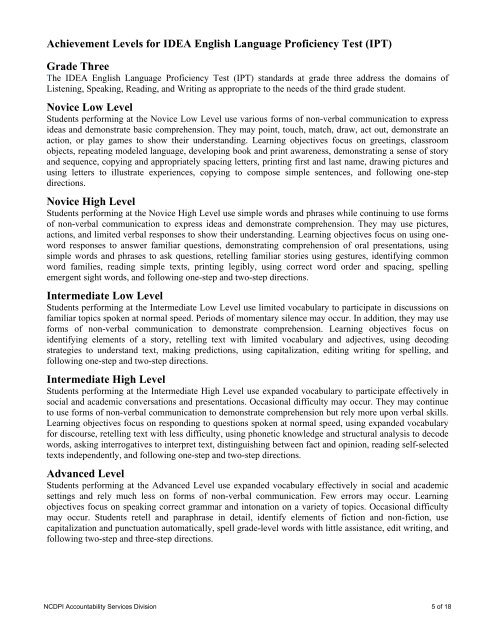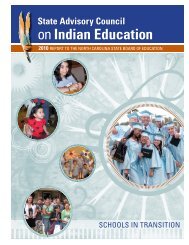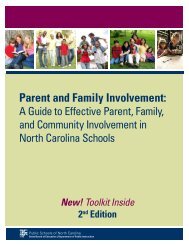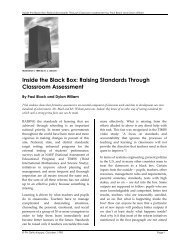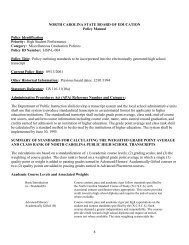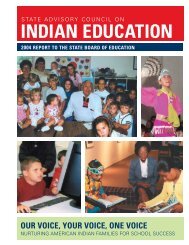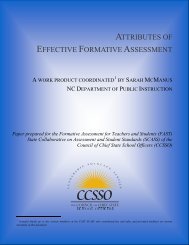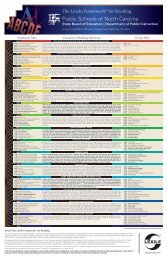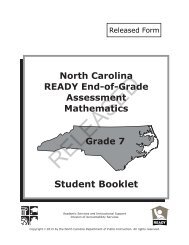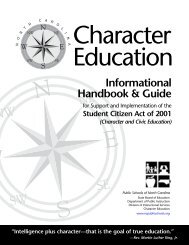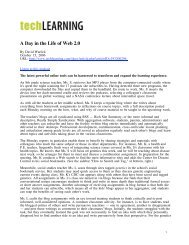Achievement Levels for IDEA English Language Proficiency Test (IPT)
Achievement Levels for IDEA English Language Proficiency Test (IPT)
Achievement Levels for IDEA English Language Proficiency Test (IPT)
Create successful ePaper yourself
Turn your PDF publications into a flip-book with our unique Google optimized e-Paper software.
<strong>Achievement</strong> <strong>Levels</strong> <strong>for</strong> <strong>IDEA</strong> <strong>English</strong> <strong>Language</strong> <strong>Proficiency</strong> <strong>Test</strong> (<strong>IPT</strong>)<br />
Grade Three<br />
The <strong>IDEA</strong> <strong>English</strong> <strong>Language</strong> <strong>Proficiency</strong> <strong>Test</strong> (<strong>IPT</strong>) standards at grade three address the domains of<br />
Listening, Speaking, Reading, and Writing as appropriate to the needs of the third grade student.<br />
Novice Low Level<br />
Students per<strong>for</strong>ming at the Novice Low Level use various <strong>for</strong>ms of non-verbal communication to express<br />
ideas and demonstrate basic comprehension. They may point, touch, match, draw, act out, demonstrate an<br />
action, or play games to show their understanding. Learning objectives focus on greetings, classroom<br />
objects, repeating modeled language, developing book and print awareness, demonstrating a sense of story<br />
and sequence, copying and appropriately spacing letters, printing first and last name, drawing pictures and<br />
using letters to illustrate experiences, copying to compose simple sentences, and following one-step<br />
directions.<br />
Novice High Level<br />
Students per<strong>for</strong>ming at the Novice High Level use simple words and phrases while continuing to use <strong>for</strong>ms<br />
of non-verbal communication to express ideas and demonstrate comprehension. They may use pictures,<br />
actions, and limited verbal responses to show their understanding. Learning objectives focus on using oneword<br />
responses to answer familiar questions, demonstrating comprehension of oral presentations, using<br />
simple words and phrases to ask questions, retelling familiar stories using gestures, identifying common<br />
word families, reading simple texts, printing legibly, using correct word order and spacing, spelling<br />
emergent sight words, and following one-step and two-step directions.<br />
Intermediate Low Level<br />
Students per<strong>for</strong>ming at the Intermediate Low Level use limited vocabulary to participate in discussions on<br />
familiar topics spoken at normal speed. Periods of momentary silence may occur. In addition, they may use<br />
<strong>for</strong>ms of non-verbal communication to demonstrate comprehension. Learning objectives focus on<br />
identifying elements of a story, retelling text with limited vocabulary and adjectives, using decoding<br />
strategies to understand text, making predictions, using capitalization, editing writing <strong>for</strong> spelling, and<br />
following one-step and two-step directions.<br />
Intermediate High Level<br />
Students per<strong>for</strong>ming at the Intermediate High Level use expanded vocabulary to participate effectively in<br />
social and academic conversations and presentations. Occasional difficulty may occur. They may continue<br />
to use <strong>for</strong>ms of non-verbal communication to demonstrate comprehension but rely more upon verbal skills.<br />
Learning objectives focus on responding to questions spoken at normal speed, using expanded vocabulary<br />
<strong>for</strong> discourse, retelling text with less difficulty, using phonetic knowledge and structural analysis to decode<br />
words, asking interrogatives to interpret text, distinguishing between fact and opinion, reading self-selected<br />
texts independently, and following one-step and two-step directions.<br />
Advanced Level<br />
Students per<strong>for</strong>ming at the Advanced Level use expanded vocabulary effectively in social and academic<br />
settings and rely much less on <strong>for</strong>ms of non-verbal communication. Few errors may occur. Learning<br />
objectives focus on speaking correct grammar and intonation on a variety of topics. Occasional difficulty<br />
may occur. Students retell and paraphrase in detail, identify elements of fiction and non-fiction, use<br />
capitalization and punctuation automatically, spell grade-level words with little assistance, edit writing, and<br />
following two-step and three-step directions.<br />
NCDPI Accountability Services Division 5 of 18


